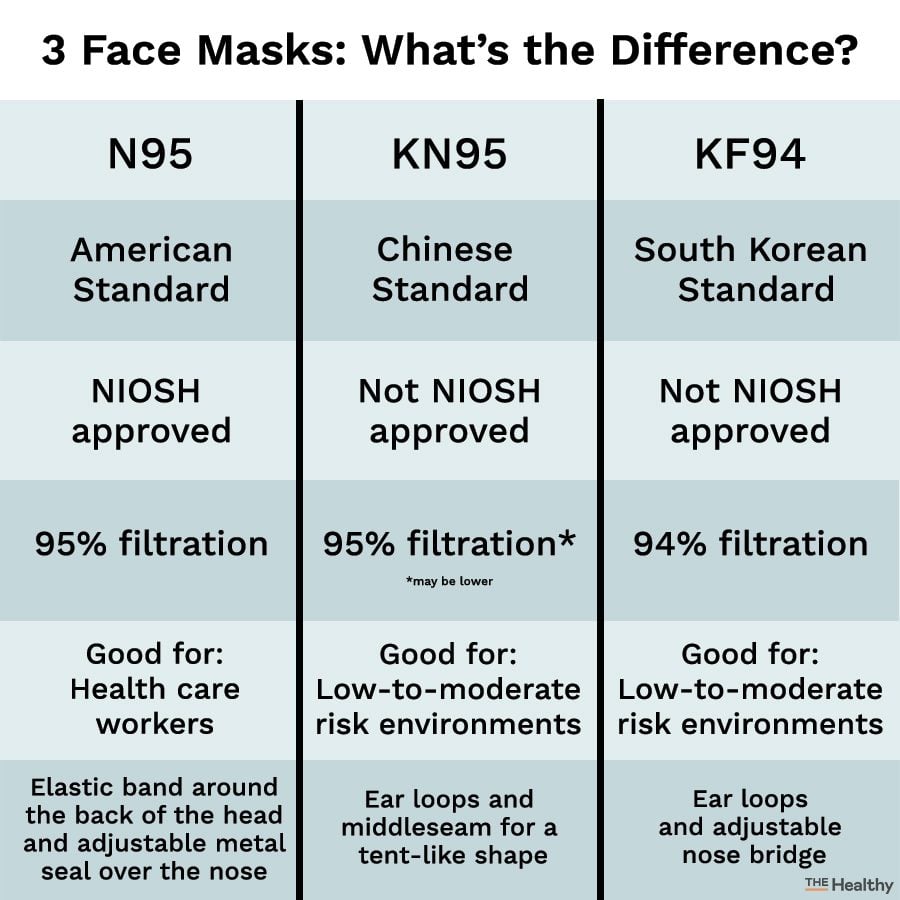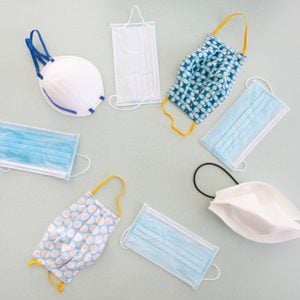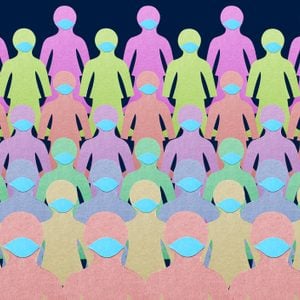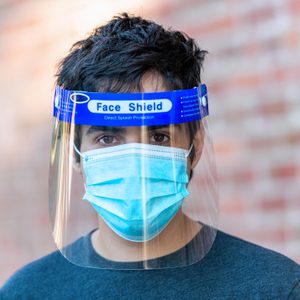N95 vs. KN95 vs. KF94 Face Masks: Which Is Better?
Updated: Feb. 16, 2021
Masks are essential gear for everyone during this pandemic—and some face masks are better than others. Here's everything you need to know about N95, KN95, and KF94 face masks.
Coronavirus face masks 101
Wearing a face mask is now a normal part of pandemic life and it’s here to stay.
“Masks are like socks, they’re ubiquitous, they’re gonna be here for the next several years, if not forever, and people need to get used to them,” says Shawn Nasseri, MD, otolaryngologist (an ear, nose, and throat specialist) and surgeon at Cedars Sinai in Los Angeles.
Knowing how important it is to wear a mask is just the beginning. The next step is figuring out which types of masks offer the best protection. (Here are the worst face masks for Covid-19.)
Most people know that the N95 mask offers good protection, but what about its distant cousin—the KF94? Or the KN95 face mask? Here’s what experts want you to know about these masks and how to choose the best option for you.
What is an N95 face mask?
The N95 medical-grade respirator mask filters at least 95 percent of airborne particles. That includes bacteria and viruses, like SARS-Co-V2, which causes Covid-19.
Therefore, it’s not surprising that a 2020 study in Science Advances ranking 14 different masks found that N95s offer the best protection against the respiratory disease.
N95 face masks have multiple layers. The outer layer is made of non-woven polypropylene fiber, which prevents external moisture from entering the mask. Then there are another two layers of that material as well as a support layer giving the mask its shape.
The innermost layer is another hydrophobic (moisture-repelling) non-woven polypropylene to keep droplets within the mask from entering the mask material. Elastic strings stretch around the head to hold the mask snugly in place, preventing air from bypassing the mask.
Some N95s feature a valve, which makes it easier to breath because you can expel unfiltered air—which keeps the wearer safe but not anyone in the near vicinity. (For that reason, health experts warn not to buy any face masks with valves.)
The N95 masks are certified to fit and are approved by the National Institute for Occupational Safety and Health (NIOSH). The NIOSH regulates these masks and puts prototypes from different manufacturers through a rigorous testing process.
Only after being certified are they approved as medical-grade masks, says pulmonologist Hugh A. Cassiere, MD, the director of Critical Care Services for North Shore University Hospital.
Since N95 masks offer ideal protection, they should probably be reserved for health care workers in close contact with potential Covid-19 patients and/or frontline workers, Dr. Cassiere and Dr. Nasseri say. The CDC also recommends that people avoid wearing masks intended for health care workers.
What is a KN95 face mask?
KN95 face masks are regulated by the Chinese government, filter 95 percent of particles, and are not NIOSH-approved. Earlier in the pandemic, when N95s were scarce, the FDA granted an “emergency use authorization” for KN95 masks. They have since been removed from the emergency use authorization list after further research on their effectiveness.
The Emergency Care Research Institute (ECRI), a non-profit patient safety organization, tested 200 KN95 masks from 15 different manufacturer’s models and found that 60 to 70 percent of imported KN95 masks do not filter 95 percent of aerosol particulates. Therefore, they don’t meet U.S. standards for effectiveness.
KN95 face masks look similar to N95 masks, but the former have a middle seam to create a tent-like shape. Much like N95 face masks, KN95 masks are also made of several layers of material.
Most KN95 face masks attach with ear loops rather than bands around the head.
What is a KF94 face mask?
KF94 masks filter 94 percent of aerosol particulates and are not NIOSH-approved either, Dr. Cassiere says. The KF stands for Korean filter as these masks meet the South Korean government’s standards.
These masks have some similarities and differences versus N95 masks. The most obvious difference is the percentage of particles the masks filter: 95 versus 94. KF94s are disposable masks that work well because they have a three-layer filter, according to Dr. Nasseri. (These are the best face masks with filters.)
Another difference is their fit. “Instead of that one-cup avocado shape, KF94s tend to be bellowed forward where it has a fold for the nose, so it does give you a little bit more breathing room,” Dr. Nasseri says. The KF94s have ear loops, an adjustable nose bridge, and side flaps.
Note that like the KN95 masks, KF94 masks are not currently on the U.S. Food and Drug Administration’s (FDA) list of emergency use-authorized face masks.
Like any other mask, however, you need to make sure it fits you in order for it to work. You must make sure the nose wire seals around the nose for it to be effective, Dr. Nasseri warns.

Should you get a KF94 face mask or a KN95 face mask?
Research comparing all three masks directly is limited. One small 2020 study in Infectious Diseases comparing surgical masks, N95 face masks, and KF94 face masks found that surgical masks were less effective in filtering viral particles from coughing Covid-19 patients than either the N95 face mask or the KF94 face mask. So they were comparable in blocking Covid-19-causing particles.
As for KN95 face masks, remember that research from the ECRI found that 60 to 70 percent of imported KN95 masks don’t filter 95 percent of particles. And neither the KN95 nor the KF94 masks currently have NIOSH approval. (Find out if two Covid-19 face masks are better than one.)
Any mask is better than no mask. And even though KN95 and KF94 masks don’t meet NIOSH standards, they are probably still better or more protective than basic surgical masks and cloth face masks. However, double-masking can help protect against Covid-19.
So if you want extra protection without taking supplies like N95s away from health care and frontline workers, KF94s or KN95s are a good option.
Beware of counterfeit masks
Finding a true KF94 or KN95 mask for sale is challenging. According to Dr. Nasseri, it’s difficult to determine a real one unless you know the language and can read the fine print.
“It’s hard to tell if it’s from a factory that is actually correctly certified for that standard, or if it’s a counterfeit,” he says. He estimates that counterfeits could be anywhere between 5 to 25 percent of what’s available for purchase.
In fact, counterfeits aren’t only an issue for non-U.S. grade masks. Millions of counterfeit N95 masks were bought in five U.S. states for hospitals, medical facilities, and government agencies, according to the Associated Press.
Dr. Nasseri says there are a few ways to judge the legitimacy of a mask. Make sure it has a good fit, that there’s no foul smell, and that you can not blow out a candle while wearing the mask. If you can check off all of the above, it’s probably good, he says.
“A foul chemical smell that makes the mask wearer nauseous sometimes is typically is a tip-off,” Dr. Nasseri explains. This could be a sign that the factory used substandard materials or that they may have missed any number of steps in the mask-making process.
Another good reference is this list from the Centers for Disease Control and Prevention (CDC) of manufacturers whose KF94s and KN95s have passed a filter efficiency test similar to the one used on N95s. The list also includes known counterfeits. The CDC also offers additional advice on how to purchase respirators from another country.
Other tips to spot counterfeits, per the CDC:
- No approval (TC) number on filtering facepiece respirator or headband
- No NIOSH markings, or incorrect spelling of NIOSH
- Decorative fabric
- Claims the mask is approved for children
Comfort is important
Although KF94 masks filter and seal well and are good options for situations such as large public gatherings or small spaces without lots of ventilation, Dr. Nasseri says there is a caveat.
If the mask disrupts breathing so much that you need to take it off to catch your breath, it’s counterproductive. And that goes for KN95s, too. (These are the other worst face mask mistakes.)
“If you’re not used to it, then you tend to touch your mouth and face and constantly adjust it to constantly suck some air in through the sides, which completely defeats the purpose of it,” Dr. Nasseri says. “Being well covered is far better than having to adjust, breathing through the sides, and venting.”
If the fit of the mask is uncomfortable and forces you to constantly adjust it, then it’s not offering much protection.
Environmental impact
There is another glaring issue when it comes to N95s, KN95s, and KF94s—you can use them for a day or so, but they aren’t exactly something you can reuse and wash consistently without special equipment.
“It’s a much more sustainable option to have washable cloth masks so you can use them for months and not just be polluting the environment,” Dr. Nasseri says. (Here are the face mask accessories you need.)
The last word
The difference between the N95 face mask, KN95 face mask, and KF94 face mask comes down to a few things: NIOSH approval, how well they filter particles, their shape and elastics, and their availability. KN95s and KF94s may be good options for non-healthcare workers who want better protection than surgical or cloth masks.
Remember, the fit is absolutely the most crucial part of finding the best face mask for you, according to Dr. Nasseri. “They have to fit. If it doesn’t fit and it’s loose, and you’re breathing all around it, that’s not an N95 or a KF94 that effectively defaults to cloth mask if you don’t have a good seal around it,” Dr. Nasseri says.
Next, here are the best cold-weather face masks you may want to try.



